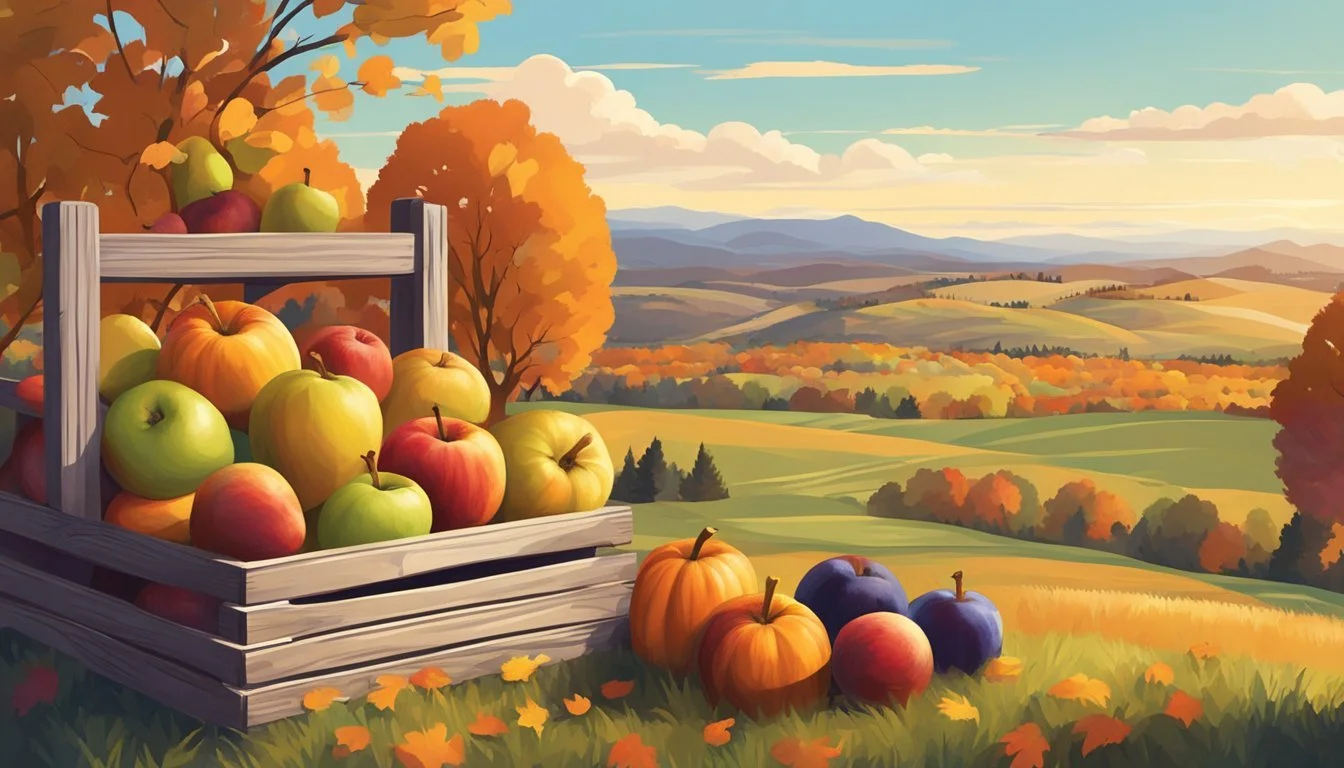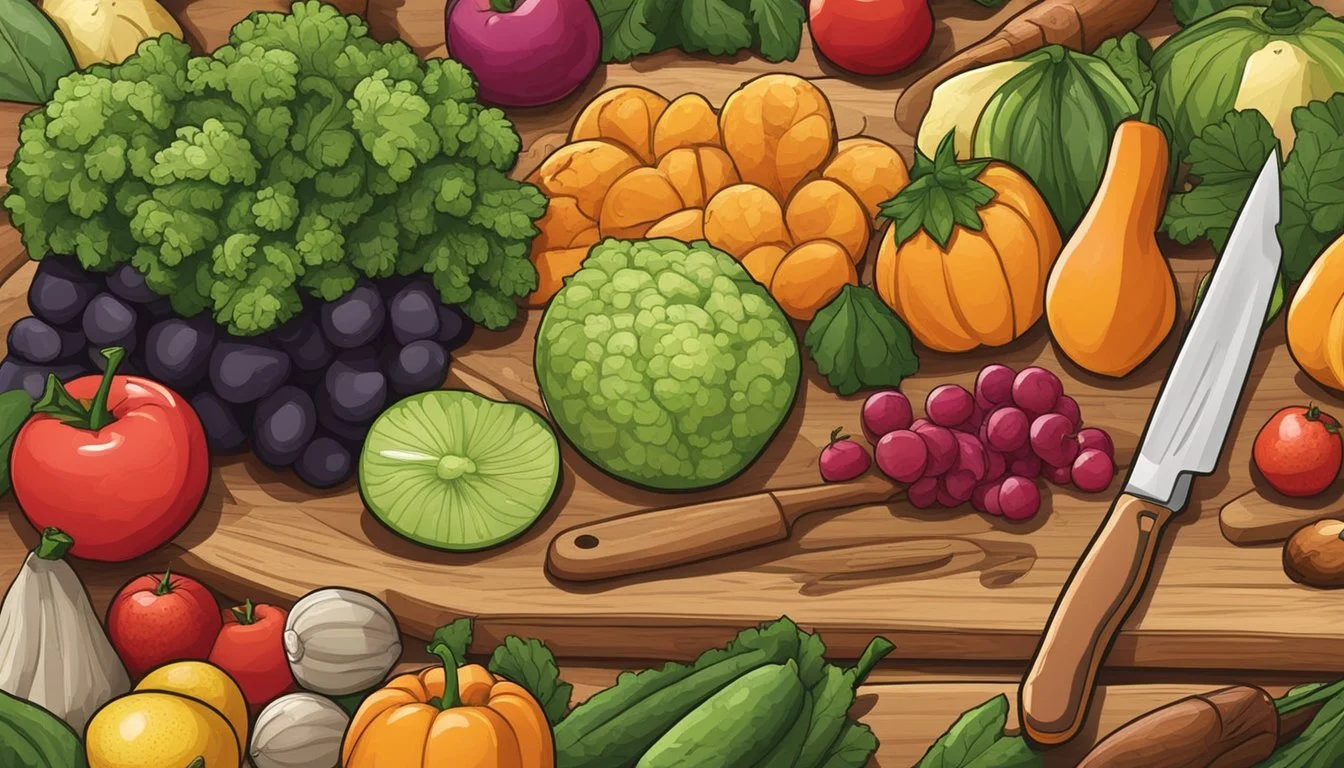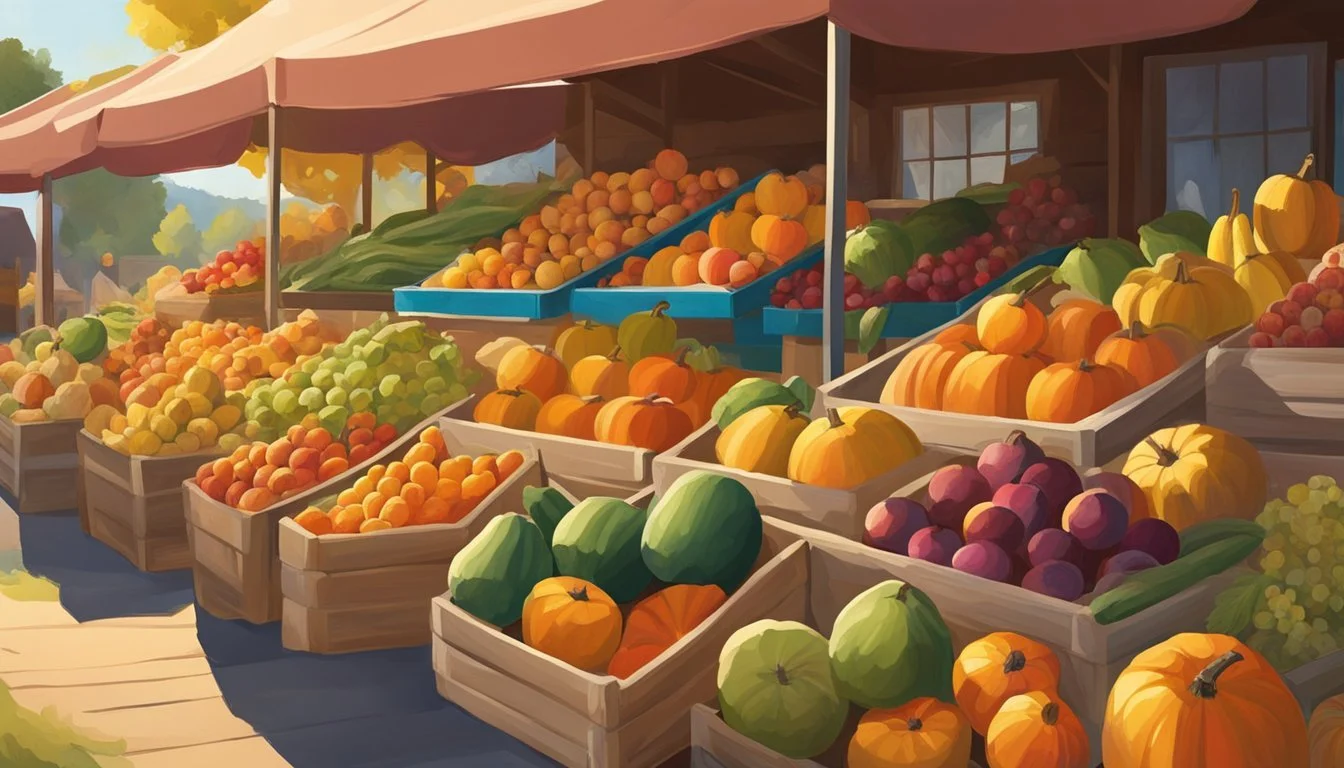Montana Seasonal Fruit & Vegetables in September
Your Harvest Guide
This Article is Part of our Montana Seasonal Fruit & Veg Calendar
Montana’s climate, marked by cold winters and warm summers, shapes a unique harvest calendar, particularly for September when the transition from summer to fall offers a diverse range of ripe fruits and vegetables. September in Montana is a bountiful time for local produce, with the harvest at its peak for many fruits and vegetables. Farmers and gardeners across the state are gathering the last of the summer yield and beginning to pick the early fall offerings.
During this month, the fields and orchards are abundant with rich and flavorful produce. Apples (how long do apples last?), a fall staple, begin to reach maturity, their varieties ranging from sweet to tart, each perfect for different culinary uses – from fresh eating to baking. Gardens are full of root vegetables like carrots (how long do carrots last?) and beets (how long do beets last?), which have been sweetened by the cooler nights. Leafy greens such as chard and collards are also in season, offering a nutritious addition to meals.
Vegetables like cauliflower (how long does cauliflower last?) and broccoli are ready for harvest, with their edible leaves providing an extra source of greens. Melons, like cantaloupe, offer a last taste of summer's sweetness, often harvested until the first frost. Montana’s September harvest promises a profusion of fresh choices for those looking to eat locally and seasonally, as the state showcases its agricultural variety before the winter sets in.
Montana's Seasonal Calendar
Montana's diverse climate and fertile soil contribute to a rich agricultural landscape. During September, the state enjoys a varied selection of fresh produce.
Understanding Seasonality
Montana's seasonal calendar reflects the state's unique climatic zones, which support a wide range of fruits and vegetables. With a growing season that shifts depending on altitude and regional weather patterns, local farmers strategically plant crops for optimal harvest times. As a result, consumers can enjoy fresh, seasonal food that is richer in flavor and nutrition.
September's Bounty
In September, one can experience the peak of Montana's harvest. The following table lists some of the produce typically available during this month:
Fruits Availability Apples Abundant Plums Current Pears In Season
Vegetables Availability Carrots Plentiful Beets Ready to Eat Broccoli Available
September's produce is teeming with flavor, having benefited from the full growth season. The fresh fruits and vegetables are not only important for local cuisine, but also signify Montana's agricultural prowess.
Key September Fruits in Montana
Montana’s September harvest brings a bountiful variety of fruits, including the last of summer’s sweet offerings and the beginning of autumn’s crisp favorites.
Stone Fruits in Season
Peaches: They reach their peak sweetness and juiciness in early September.
Plums: Available in a range of varieties, plums offer a sweet and tart flavor perfect for fall.
Berries and Melons
Raspberries: These berries are among the last of the summer fruits to be harvested in September, delivering a rich and tart flavor.
Cantaloupe: Known for its sweet and refreshing taste, cantaloupe thrives in Montana's late summer climate.
Apple Varieties
Apples: A signature fruit of the fall, several varieties of apples become ripe for picking throughout September. Each variety has its own unique flavor profile and culinary uses:
McIntosh: Tart and tender, ideal for sauces and pies.
Honeycrisp: Crisp and sweet, perfect for eating fresh.
Gala: Mild and sweet, suitable for both fresh eating and cooking.
Featured Vegetables of September
September in Montana showcases a rich harvest with a focus on earthy root vegetables and a bounty of squash varieties. Below is a detailed overview of the vegetables featured during this month, segmented into categories for easy reference.
Root Vegetables and Tubers
September marks an excellent time for harvesting root vegetables and tubers in Montana. Carrots and beets offer vibrant colors and are packed with nutrients. Subterranean staples such as potatoes and sweet potatoes are also ready to be dug up, adding hearty flavors to fall dishes.
Squash and Pumpkins
The cooler weather ushers in the harvest for various types of squash and pumpkins. Winter squash, including varieties like acorn and butternut, provides creamy textures and sweet flavors suitable for both savory and sweet preparations. Pumpkins, symbolic of autumn, are not only for decoration but also for cooking, rich in vitamins and versatility.
Leafy Greens and Salads
Leafy greens such as lettuce, spinach, and kale thrive in the cooler September climate of Montana. They are ideal for nutritious salads and add a crisp freshness to any meal. These greens are rich in fiber and essential minerals, making them a healthy addition to one's diet.
Nightshades and Gourds
September still offers a harvest of nightshades like tomatoes and eggplant, though they are at the end of their growing season. These vegetables bring a depth of flavor to a plethora of culinary dishes. Peppers also range from sweet bell varieties to hotter ones, providing a kick of flavor and a bounty of health benefits.
Harvest and Storage Tips
In September in Montana, farmers and gardeners harvest a variety of fruits and vegetables, using specific techniques to ensure produce quality. Proper storage methods are vital to extend the shelf life of the produce, keeping it fresh and crisp for as long as possible.
Proper Harvesting Techniques
To maximize quality and longevity, each type of produce should be harvested at its optimal time and with the appropriate method. Tender vegetables and fruits should be picked gently to avoid bruising. Firm produce, such as root vegetables, should be harvested on a dry day to reduce dirt sticking and minimize the risk of mold.
Tender Produce (e.g., tomatoes, raspberries):
Harvest in the cool morning hours.
Use shears or snip to avoid damaging the plant or the fruit.
Firm Produce (e.g., potatoes, carrots):
Harvest when the soil is dry.
Gently dig around the base, lifting carefully with a spade or fork.
Extending Shelf Life
After harvest, the way fruits and vegetables are stored greatly affects their longevity. Refrigeration is key for certain tender items, while others prefer a cool, dry environment.
In the Fridge:
Store tender leafy greens in a plastic bag or container.
Keep ripe fruit in crisper drawers to maintain humidity.
Cool, Dry Storage:
Potatoes and onions last longer in well-ventilated, dark places.
Ensure firm vegetables are clean and dry before storage.
By adhering to these methods, one can effectively maintain the quality of harvested produce and enjoy the flavors of the season for an extended period.
Preparing Seasonal Dishes
As September arrives in Montana, the range and richness of available produce provide an excellent platform for both inventive cooking and preserving the harvest. Chefs and home cooks alike lean into the fall season with dishes that highlight the fresh, seasonal flavors.
Delicious Recipes with September Produce
Salads: The crisp texture and vibrant flavors of raw vegetables come to life in salads. Cooks can combine lettuce, spinach, and kale to create a nutritious green base. To add color and sweetness, one might toss in diced carrots, shredded cabbage, or even sliced apples for a crunch. A homemade pesto dressing using fresh herbs could add a robust flavor.
Heavy Dishes: Hearty meals become comforting as evenings grow cooler. Stews and fried vegetable dishes make use of the harvest by transforming cauliflower, broccoli, and root vegetables like parsnips into warming experiences. Served over a bed of rice, these vegetables absorb the flavors of the seasonings and add substance to any meal.
Canning and Preserving Methods
Canning Fruits: As the last of the summer's sweetness overlaps with early fall, canning fruits such as apples sets the stage for year-round enjoyment. Apple varieties, when cooked down into applesauce, can be canned and stored, featuring the pure taste of the orchard in every spoonful.
Pickling Vegetables: Vegetables like cauliflower and carrots are prime candidates for pickling. They retain a satisfying crunch and develop a tangy flavor profile that enhances sandwiches, salads, and snacks. Preserving these vegetables may involve simple brine solutions or slightly more complex recipes with herbs and spices for added depth.
By taking advantage of Montana's September produce, one can create dishes that are both gratifying and true to the season's offerings. Whether the produce is served fresh, cooked in a meal, or preserved for later use, these methods pay homage to the local agriculture and the change of seasons.
Health Benefits of Seasonal Eating
Seasonal eating in regions like Montana not only maximizes the taste and nutritional value of produce but also reinforces the local agricultural community. By choosing locally grown, seasonal fruits and vegetables, consumers contribute to their health and the vitality of the region's farming economy.
Nutritional Value of Produce
Consuming produce at its peak seasonality ensures individuals are getting higher levels of vitamins, minerals, and antioxidants. In September, Montana offers a variety of fruits and vegetables that can enhance a diet with optimal nutritive content. For example:
Apples: Rich in fiber and vitamin C.
Pears: Good source of vitamin K and fiber.
Carrots: Contain beta-carotene and other antioxidants.
Beets: High in folate and manganese.
The nutrient density in these foods, when harvested at the right time, is significantly higher compared to out-of-season counterparts, which often lose nutritional value during transport and storage.
Supporting Local Agriculture
Choosing to eat seasonally supports Montana’s local agriculture by:
Reducing Food Miles: Local produce travels shorter distances, which leads to lower carbon emissions.
Economic Support: Buying from local farmers puts money directly back into the local economy.
Preservation of Local Varieties: Encourages the growth of crops suited to the local environment, maintaining biodiversity.
Local produce from Montana in September not only brings health benefits but also bolsters the state's agricultural heritage and sustainability.
Where to Find September Produce
In September, the state of Montana offers a bounty of fresh produce available at various locations. Consumers looking to partake in the seasonal harvest can find an abundance of fruits and vegetables in local settings known for their freshness and quality.
Farmers Markets and Local Stores
Montana's farmers markets are a hub for locally grown, seasonal produce. They provide an opportunity to purchase directly from growers, ensuring peak freshness and flavor. Shoppers can find a variety of September produce such as apples, plums, and a myriad of vegetables including pumpkins, carrots, and leafy greens.
Key locations to note:
Billings: Yellowstone Valley Farmers Market offers a plethora of options.
Bozeman: The Gallatin Valley Farmers Market is known for its wide selection.
Missoula: Missoula Farmers' Market hosts vendors from across the state.
Local stores, especially those focusing on natural and organic selections, often stock produce sourced from within the state. Consumers can check store maps or seek assistance from staff to find the Montana-grown section.
Foraging in the Wild
For those inclined to venture into nature, foraging for wild fruits is another way to enjoy Montana's September offerings. Huckleberries and chokecherries are among the wild fruits that can be collected. Foragers must be knowledgeable about the safe practices and legalities of harvesting in public lands and private properties.
Foraging Guidelines:
Identify accurately: Ensure correct identification to avoid picking inedible or harmful species.
Follow state guidelines: Consult Montana’s foraging regulations on state park websites or maps to ensure compliance with local laws.
Sustainable practices: Only take what is needed and leave plenty for wildlife and future growth.
Conclusion
In Montana, September marks a transitional period where the remnants of summer's bounty meet the initial offerings of fall's harvest. The selection of seasonal fruits and vegetables is robust, providing consumers with a wealth of fresh options.
Seasonal Fruits:
Apples, both early and mid-season varieties, are abundant in September. They can be enjoyed fresh, baked, or preserved.
Plums also reach their peak, offering a juicy and sweet addition to the fruit selection.
Local Vegetables:
Vegetables typically harvested during this month include:
Root vegetables: such as beets and carrots, which have matured into their full flavor.
Brassicas: like kale and cabbage, which start to thrive in the cooling weather.
Farmers' markets in Montana showcase these seasonal offerings, underlining the state's agricultural diversity. Consumers have the opportunity to support local farmers and enjoy produce at its freshest, often reaped less than 24 hours prior to purchase.
The availability of specific fruits and vegetables may slightly vary due to the year's unique climate conditions. Nonetheless, September remains an ideal month for exploring Montana's regional produce and enjoying the overlap of summer's end and autumn's onset.









